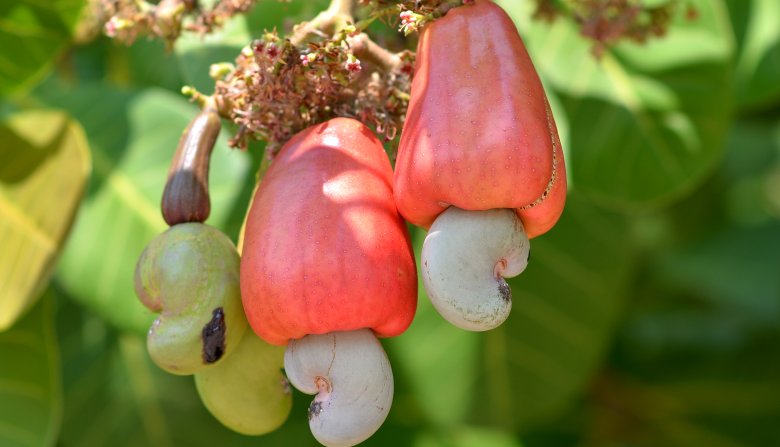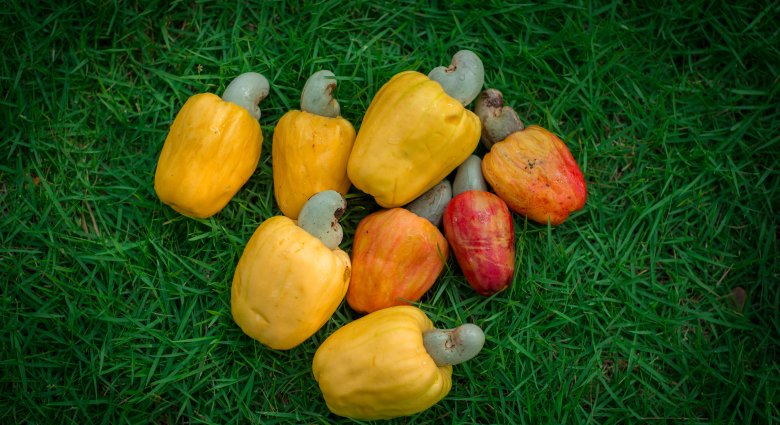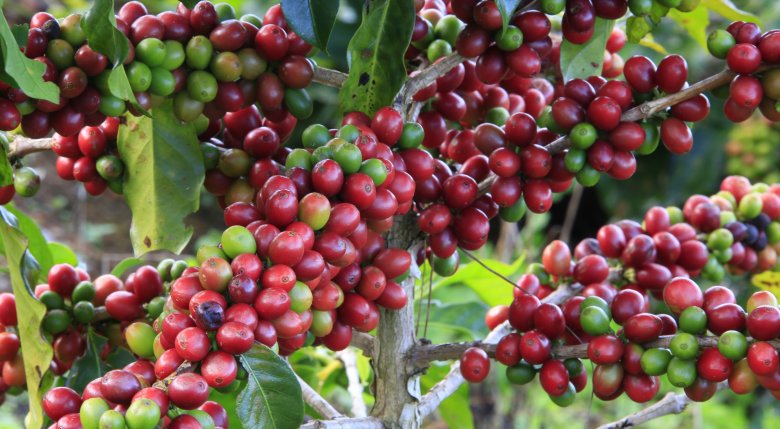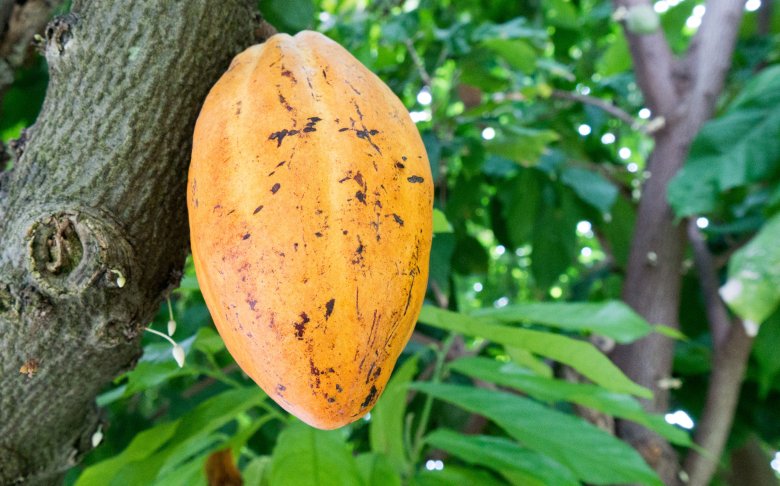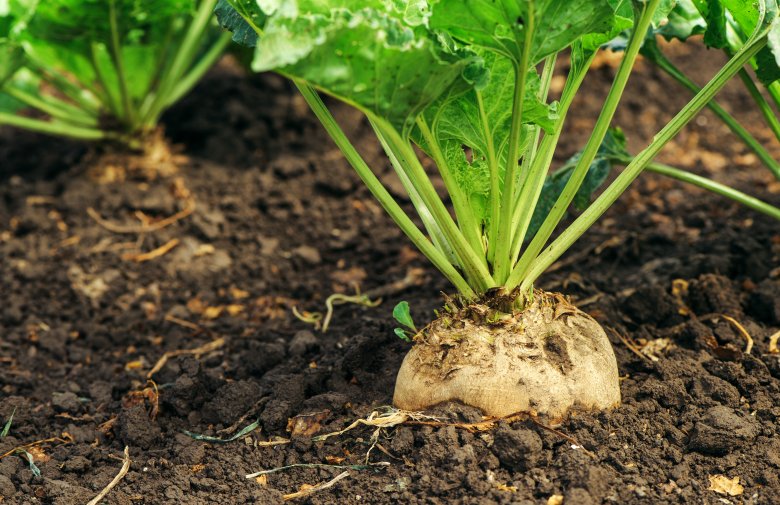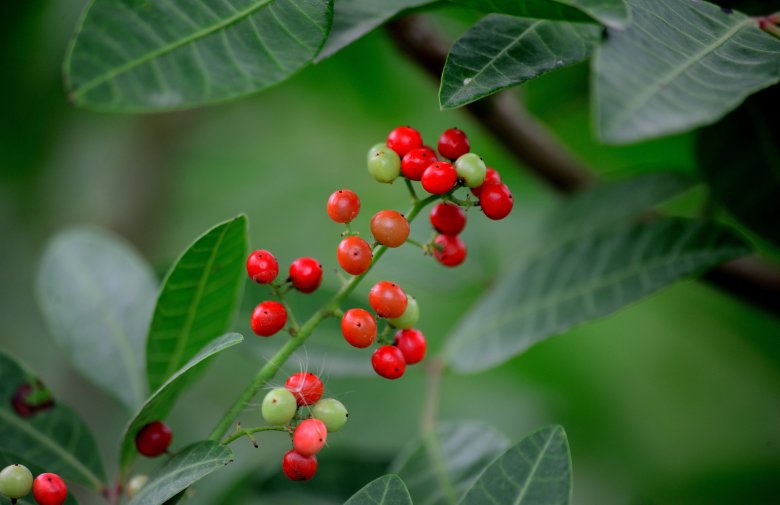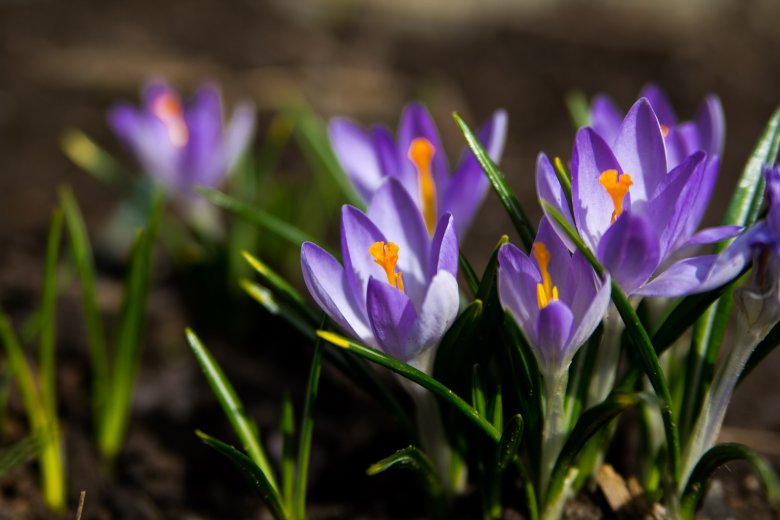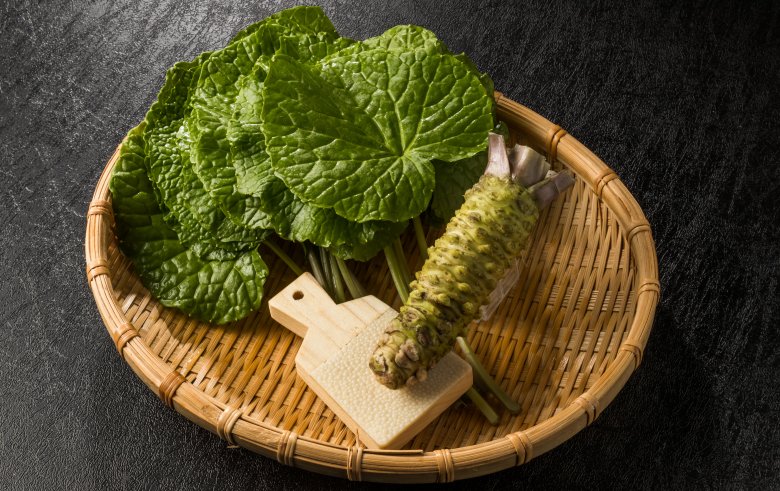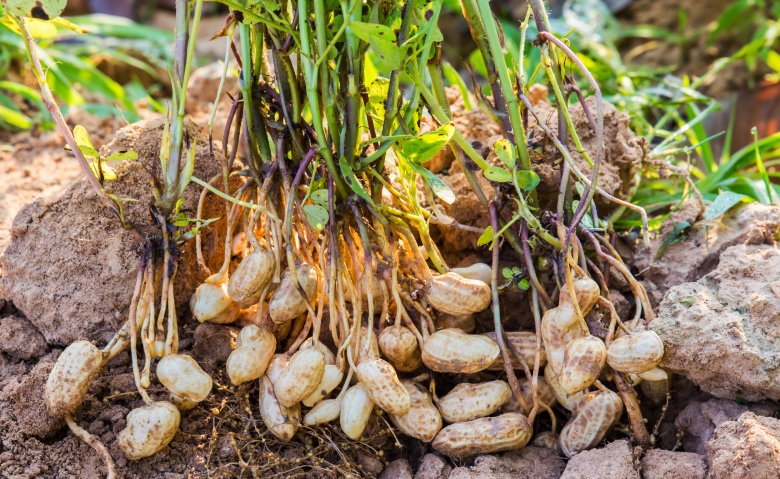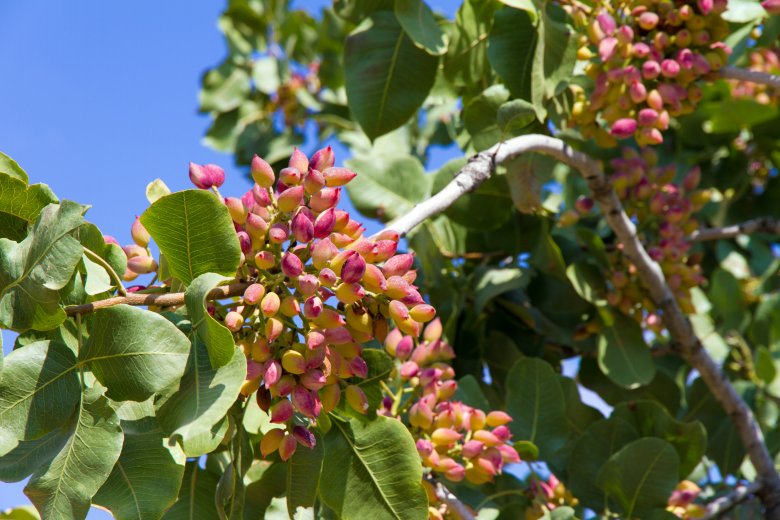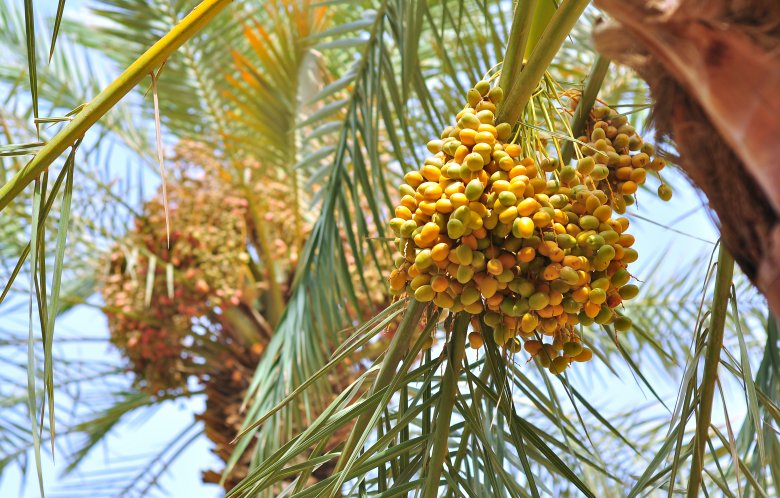Foods You Wouldn't Recognize In Their Natural State
Most natural foods tend to come as we find them — you can't miss an apple growing on an apple tree, for example. That's not necessarily the case with everything, however, and some things go through quite the transformation over the course of their culinary lives. Some are harvested in certain ways, others are processed so much they end up appearing completely different than how they started off, and others simply come from more bizarre-looking sources. They've all got one thing in common, though: if you saw any of these foods in their natural form, you'd more than likely be completely unable to recognize them.
Cashew nuts
Everybody knows what a cashew nut looks like. Their curved, banana-like shape and vibrant color are about as iconic as a nut can get. Their frequent use in Indian, Thai, Chinese and other Asian cuisines has cemented their popularity as one of the all-time great nuts for cooking, too. It's surprising, then, just how surprised people often are when they see the cashew's true form for the first time.
The cashew tree is a large, tropical tree that's native to Brazil but now exists all over the world. The fruit — which is known as a cashew apple — looks about as far from a nut as you can imagine, being bulbous, yellow-red in color and pepper-like in appearance. The nut is attached to the end, and extracting it can be a difficult affair, considering cashew nuts themselves contain cardol and anacardic acid, which can cause some pretty nasty burns. Despite this, the cashew apple is actually edible, and is often consumed like any other fruit.
Coffee
Think of coffee and one very clear image will probably come to mind: that of coffee grounds or beans, which are well known for their small size and dark brown coloring. Coffee beans are seeds, however, and like any seeds come from a plant which looks very different to how you might expect. Coffee is a genus of shrub and tree, native to Asia and Africa, that produces a small, edible berries that are usually red, yellow or purple, and which contain the seeds that coffee consists of. It takes up to nine months for the fruit of the plant to reach full maturity, after which they're harvested for the coffee within. If you're wondering, the berry apparently tastes fleetingly of watermelon, rosewater and hibiscus.
Cocoa
Like coffee, the cocoa bean is the seed of a plant that, at first glance, you might not exactly associate with chocolate. Known as the cocoa (or cacao) tree, it famously grows in the tropical regions of South America. Theobroma cacao, to give it its proper denomination, can grow up to eight meters tall and produces clusters of yellow, brown or purple fruit which contains the cocoa beans themselves.
To make chocolate, the flowers of the cocoa are left to pollinate, after which the seeds are harvested and crushed to create cocoa mass, which eventually becomes chocolate. As for the cocoa fruit itself, it is indeed edible, and is said to have a particularly zesty flavor.
Sugar
Sugar might appear in your kitchen as a fine, white powder, but in almost every regard — including how it looks and tastes — its original form is about as different as you can get. Sugar is grown from the sugar beet, which has the appearance of a kind of fatter parsnip, and tastes a bit like a sugary potato.
The beet is harvested, washed, and cut into pieces before being doused in hot water to extract the sucrose it produces. The resulting syrup then crystalizes and becomes the sugar we all know, love and ought to try to eat less of.
Sugar can also be made from sugar cane, a plant native to tropical regions, which looks a little bit like bamboo, and which is subjected to a similar process to create sugar.
Black pepper
Black pepper may appear black, hard and crushed on the plate, but the peppercorn itself is none of those things. In fact, pepper in its natural state looks indistinguishable from most berries. Black pepper plants, otherwise known as Piper nigrum, are a type of vine native to India but now found in most tropical regions. That are notoriously valuable and difficult to grow, and produce a large number of small fruits. Depending on their level of maturity, these fruits can appear black, green or red. The fruit is taken from the tree and dried — turning black through the process of oxidization — before being shipped out and exported for gastronomic use.
Saffron
Saffron might be one of the more underrated spices out there, but that doesn't mean it's not a might addition to any spice rack, being especially useful for soups, stews, paella, risotto and seafood dishes — it's even got its fair share of health benefits. While you might recognize saffron as a strange, long and red-colored substance, it's actually taken from the flower of a plant known as the saffron crocus.
The saffron crocus is a pretty, pale and purple flower which is easily grown in any suitable environment. The stigma of the flower (that's the long bit you'll find in the middle which makes up a third of the plant's reproductive system) is what's harvested from the crocus to make saffron. If you're lucky enough to find a crocus and recognize it as the source from saffron, you can harvest it by simply carefully plucking the stigma from it and storing it in a dry, warm place. If not, you could always grow them yourself — it's not difficult, and is bound to save you a lot of money that you'd normally spend on the pre-harvested spice.
Wasabi
For many, wasabi is only encountered as a powdered coating for another food, or perhaps in its form as a green, avocado-like paste. The plant itself, which is closely related to the mustard and horseradish plants, is one of the world's most expensive crops and, when viewed from afar, is completely unassuming. Even once taken from the earth, the part of the plant that prepared wasabi comes from takes on a particularly strange appearance, a little like a cross between a carrot and a pineapple.
This is the stem of the wasabi, which is harvested from the plant and ground into paste. The leaves of the wasabi plant are also edible, offering a salad green-like flavor with a touch of wasabi spice to them.
Peanuts
The peanut, like an alarmingly high amount of other types of nut, is pretty deceptive by nature. You'd be able to spot one from a mile off out of its shell, and from half the world away when it's inside it (the shape of the peanut shell being nothing short of unmistakable) but the peanut is also known as the groundnut for a reason: it comes from a legume, with the nuts themselves buried in the dirt.
Arachis hypogaea, as it's known, originates in South and Central America, grows to about half a meter tall and is attached to a number of underground pods which are heaved up from beneath the earth, washed and cracked open to access the edible 'nuts' within. While growing, the peanut plant looks no different than any other plant you might find in your garden or in the wild. Only the thin pegs which attach the nuts to the lower leaves of the plant will be any giveaway as to what lies beneath.
Pistachios
Another win for the nuts here, with the pistachio — which, considering its duplicity, is quite unsurprisingly related to the cashew. If you head down to a store right now and pick up a packet of pistachios, it's likely that they'll have been sun-dried and then roasted for the purposes of consumption, but the seeds of the tree (which is also known as the pistachio) are actually a yellow-red color and grow in bunches on the higher branches.
They may not look entirely unlike many fruits, but it's best not to taste them off the branch, because some pistachios have been found to contain traces of aflatoxin, which can be fatal if consumed by a human. You're probably best sticking to the roasted ones.
Dates
Dates, as you'll find them, are soft, wrinkly and dark in color. This is because they're a form of dried fruit, and the date that's taken off the tree takes on a very different appearance. The tree in question is the date palm, an impressive-looking (and very tall indeed) tree which originated in the Middle East. On the palm, dates are large and bright, and while it's very clear that it's a fruit up there, anybody who's not familiar with the cultivation process would be lucky to guess that those fruits end up looking anything like the finished product.
As it happens, it is possible to get your hands on fresh dates, though they're fairly difficult to find, it's worth a go anyway — they're far lower in calories than their dried compatriots.
